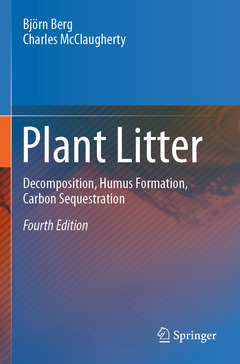Description
Plant Litter (4th Ed., 4th ed. 2020)
Decomposition, Humus Formation, Carbon Sequestration
Authors: Berg Björn, McClaugherty Charles
Language: English
Subjects for Plant Litter:
168.79 €
In Print (Delivery period: 15 days).
Add to cartPublication date: 12-2021
332 p. · 15.5x23.5 cm · Paperback
158.24 €
In Print (Delivery period: 15 days).
Add to cartPublication date: 12-2020
332 p. · 15.5x23.5 cm · Hardback
Description
/li>Contents
/li>Comment
/li>
This book gives basic facts about litter decomposition studies, which are of guidance for scientists who start studies. Since the publication of the third edition, there has been quite a development not only in the field of litter decomposition but also in supporting branches of science, which are important for fruitful work on and understanding of decomposition of plant litter and sequestration of carbon. A consequence is that ?old established truths? are becoming outdated.
New knowledge in the fields of phytochemistry and microbial ecology has given a new baseline for discussing the concepts ?litter decomposition? and ?carbon sequestration?. We can also see a rich literature on litter decomposition studies using roots and wood as substrates. These have given new insights in factors that regulate the decomposition rate and as regards roots their contribution to sequestered carbon in humus. Additional facts on the role of temperature vs the litters? chemical compositionmay in part change our view on effects of climate change.
Further information on applications of the new analytical technique (13C-NMR) for determining organic-chemical compounds has allowed us to develop these parts.
Focus is laid on needle litter of Scots pine as a model substrate as this species has been considerably more studied than other litter species. Also the boreal/northern temperate coniferous forest has in part been given this role. Still, new information may allow us to develop information about litter from further tree species.Chapter 1 - Introduction.- Chapter 2 - Decomposition as a process: Some main features.- Chapter 3 - Decomposer organisms.- Chapter 4 - Initial litter chemical composition.- Chapter 5 - Changes in substrate composition during decomposition.- Chapter 6 - Chemical constituents as rate regulating: Initial variation and changes during decomposition.- Chapter 7 - Climatic environment.- Chapter 8 - Decomposition of fine root and woody root litter.- Chapter 9 - Decomposition of woody litter and cones.- Chapter 10 - Models that describe litter decomposition and influences on decomposition patterns.- Chapter 11 - Influences on stable litter fractions and carbon sequestration in organic layers.- Chapter 12 - Carbon sequestration rates on a regional scale.
These books may interest you

Marine Anthropogenic Litter 52.74 €



